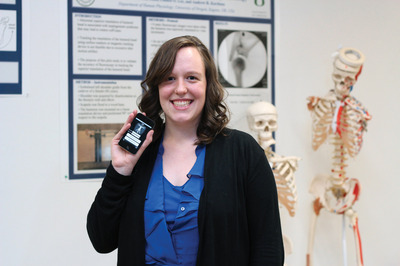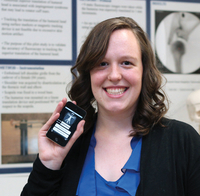For the ambitious undergraduate drawn to human physiology research, the question isn’t what to study. It’s what not to.
Cardiopulmonary systems. Exercise and muscle physiology. Motor control. All of these areas of UO faculty expertise create opportunities for undergraduate research experience. For good measure, the Department of Human Physiology also features a climate-controlled environmental chamber that, with the press of a button, can plunge to zero degrees Fahrenheit, or zoom up to 130, allowing researchers to observe and assess the human body under physical stress conditions.
 For Lizzy Gillespie (right), the answer was scapular biomechanics. Gillespie was a sophomore honors student looking for thesis ideas when she introduced herself in 2010 to associate professor Andy Karduna. Karduna studies occupational disorders— research with the imminently practical goal of improving health—and Gillespie found this intriguing.
For Lizzy Gillespie (right), the answer was scapular biomechanics. Gillespie was a sophomore honors student looking for thesis ideas when she introduced herself in 2010 to associate professor Andy Karduna. Karduna studies occupational disorders— research with the imminently practical goal of improving health—and Gillespie found this intriguing.
Karduna gave Gillespie two options for developing a thesis and exploring the world of research: Work under a graduate student or, as Karduna put it, pursue “this crazy idea that an iPod Touch might be a tool for our lab.”
Not a tough choice.
Gillespie, great granddaughter of former university president Robert Clark and a student in the Robert Donald Clark Honors College, has spent three years studying the iPod’s effectiveness for measuring proprioception. Often referred to as the “sixth sense of position and movement,” proprioception is the sense of one’s body orientation and movement in space without the use of sight.
Doctors and physical therapists test motor control and nerve damage with proprioceptive tests during which subjects are asked to copy a specific joint position—say, flexing an elbow to a 90-degree angle. But tests are typically possible only in a lab setting due to the limitations of the equipment; Karduna thought an iPod Touch might enable work to be done in the field, given it contains the same devices—a triple-axis accelerometer and gyroscope—that are used in the lab.
Although Karduna and his graduate students guided Gillespie through the project, it was essentially hers: she was instrumental in designing all experiments and coordinated the data collection.
Over the initial months of study, Gillespie recorded the iPod’s accuracy for measuring joint angles and found it to be off by no more than half a degree—better than the laboratory’s own accelerometer.
Next came creation of an app to run proprioception tests. The university’s InfoGraphics staff members developed the app with Karduna; Gillespie oversaw a series of trials that lasted more than a year, during which subjects wearing an iPod Touch used the app to run through a range of arm positions.
The climax came in Florida: Gillespie spent five days at the annual meeting of the American Society of Biomechanics in Gainesville, where, working with Karduna and two graduate students, she studied the app’s effectiveness by testing more than 100 people.
“The thing that I enjoyed the most was that it was truly my project,” Gillespie said. “I took responsibility and because I had the freedom to do with it as I might, it made me want to work harder—to get those 100 subjects, which was my goal.”
It can be intimidating to ask to join a professor’s lab, and the learning curve is steep. But Chris Minson, head of the human physiology department, said all nine tenure-track faculty members in his department rely on undergraduates for a range of laboratory duties.
“Everyone’s interested in exercise or knows someone who has a problem associated with aging or high blood pressure,” said Minson. “The work we do and the approaches we take tend to resonate very well with students.”
And what became of the iPod app? The university is studying the potential for putting it on the market.
Said Gillespie: “It would be kind of cool to say to my grandkids one day, ‘I helped invent that app.’”
— Matt Cooper
-Photos by Jack Liu



-thumb-200x200-1722-thumb-100x100-1723.jpg)


 From federal forest payments to the benefits of reading readiness, econ honors projects get real.
From federal forest payments to the benefits of reading readiness, econ honors projects get real. SPUR student receives prestigious Howard Hughes Medical Institute Award.
SPUR student receives prestigious Howard Hughes Medical Institute Award.